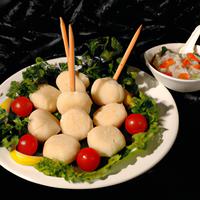
1 serving (50 grams) contains 50 calories, 6.0 grams of protein, 1.0 grams of fat, and 5.0 grams of carbohydrates.

Log this food in SnapCalorie

Nutrition Information
Calories |
238.1 | ||
|---|---|---|---|
% Daily Value* |
|||
| Total Fat | 4.8 g | 6% | |
| Saturated Fat | 1.2 g | 6% | |
| Polyunsaturated Fat | 0 g | ||
| Cholesterol | 71.4 mg | 23% | |
| Sodium | 714.3 mg | 31% | |
| Total Carbohydrates | 23.8 g | 8% | |
| Dietary Fiber | 0 g | 0% | |
| Sugars | 2.4 g | ||
| protein | 28.6 g | 57% | |
| Vitamin D | 0 mcg | 0% | |
| Calcium | 47.6 mg | 3% | |
| Iron | 1.2 mg | 6% | |
| Potassium | 238.1 mg | 5% | |
* Percent Daily Values are based on a 2,000 calorie diet. Your daily values may be higher or lower depending on your calorie needs.
Food Attributes
Source of Calories
About White fish balls
White fish balls are a popular ingredient in East and Southeast Asian cuisine, particularly in Chinese and Thai dishes. Typically made from finely minced white fish such as cod, haddock, or pollock, combined with starch and seasoning, they are shaped into bite-sized spheres. The mixture is then steamed, boiled, or fried, resulting in a springy texture and mild flavor. White fish balls are a good source of protein and low in fat, making them a relatively healthy option compared to fattier protein sources. However, some varieties may include added sodium, preservatives, or artificial flavors, so it’s important to check ingredient labels. They are commonly served in soups, hot pots, stir-fries, or as street food. Versatile and convenient, white fish balls are enjoyed for their ability to absorb the flavors of accompanying broths and sauces while providing a light, satisfying addition to meals.



